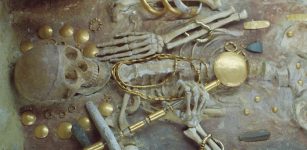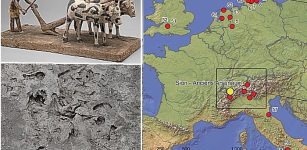Deir el-Bahri – Sacred Resting Place For The Pharaohs
A. Sutherland - AncientPages.com - Deir el-Bahri, a sacred resting place for the pharaohs, is a mountain valley on the western bank of the Nile River near Thebes, an archaeological site of tombs and temples.
Deir el-Bahari. The Mortuary Temple of Hatshepsut - aerial view in the early sunlight. Credit: Adobe Stock - WitR
In ancient times, Deir El-Bahri (Bahari), meaning "Northern Monastery," was essential to Theban's royal necropolis. It is located on the West Bank of the Nile opposite the famous Karnak, a large rock formation formed by the cliff of the plateau of the Libyan desert.
Many prominent royal figures of ancient Egypt found a resting place in the sacred area of Deir el-Bahari.
The area has a perfect geographical location, with a flat plain landscape rising gradually westwards from the Nile before suddenly ending in a steep rock wall. The wall surrounds the valley in a U-shape. At the bottom of this quiet valley, resting against the mountain wall, are the three most magnificent royal temples side by side: Mentuhotep 2's tomb and temple from about 1959 BC., Hatshepsut's famous mortuary temple was built on three terraces with inclined ramps.
In his work "Egypt's Ancient Heritage," Rodman R. Clayson writes that rows of fine columns around each terrace are arranged in a beautifully clear perspective. The columns of most Egyptian temples were in covered halls leading through growing dimness to the ultimate sanctuary.
In Hatshepsut's temple, the square columns led to spacious courts open to the sky." 1
Sculptures of pharaohs entering the Funerary Temple of Hatshepsut. Credit: Adobe Stock - unai
The capitals of some of the columns are sculptured to represent the cow goddess Hathor. This goddess nursed every king, including their mythological ancestor, the god Horus, in Egypt's distant past. The goddess Hathor, one of ancient Egypt's most outstanding female deities, had a special connection to the area from bygone times.
Hatshepsut's temple is beautiful. All credit goes to the architect Senenmut, chief of the enthusiastic and dedicated Egyptian officials who served Queen Hatshepsut. It is said that the two may have been lovers, but there is no clear evidence to support this claim. However, "Senenmut stood in some special relationship to her." 1
The temple "resembles no other of its time, although its form was doubtless suggested by the neighboring tomb complex built by Mentuhotep some 600 years earlier. Hatshepsut's building was not a tomb but a temple in honor of her "divine father," [the national god Amon-Re]… To Hatshepsut, it was the paradise of Amon, and on its approaches, she planted the myrrh and incense trees which she had brought from Punt in far Somaliland." 1
Colorful murals depicting the expedition Hatshepsut sent to the land of Punt are also stunning.
Beside her temple complex are the ruins of the monumental Temple of Mentuhotep III. Many of Egypt's great Pharaohs, such as Thutmose III and Rameses II, celebrated their campaign victories by building magnificent temples decorated with sculptures and paintings of outstanding beauty.
Another structure is the tomb temple of Hatshepsut's successor, Thutmosis III, but landslides destroyed the temple in ancient times.
Nevertheless, many architecture experts and ordinary people consider Hatshepsut's mortuary temple the most beautiful in Egypt.
Just east of the hot, dry, and silent Deir-el-Bahri on the other side of the Nile, there is the famous Karnak Temple - by far considered the largest temple complex of antiquity, dedicated to the god Amon-Ra, whose name was associated with several other gods.
Credit: Adobe Stock - Stockbym
Deir-el-Bahri also has a prominent neighborhood of the Valley of the Kings, the place where the kings of the new kingdom (around 1550-1069BC) dug out their rock tombs.
Another tomb is that of Pharaoh Amenhotep I, who was deified after his death (c. 1494 BC) and became the patron saint of this part of the famous necropolis. His wife's grave, Merit-Amon, was found nearby in 1929, but his tomb remains undiscovered.
The original location of Amenhotep's tomb has not been securely identified. A report on the security of royal tombs in the Theban Necropolis commissioned during the troubled reign of Ramesses IX informs that the tomb was then intact.
However, its location was never clearly specified.
Two possible sites for Amenhotep I's tomb have been proposed: one (KV 39), located high up in the Valley of the Kings, and the other at Dra' Abu el-Naga', Tomb ANB. Excavations at KV 39 suggest it was used (or reused) to store the Deir el-Bahri Cache, which included the king's well-preserved mummy, before its final reburial. The tomb ANB is a strongly suggested candidate because it contains objects bearing his name and the names of some family members. Sometime during the 20th or 21st Dynasty, Amenhotep's original tomb was either robbed or considered insecure and emptied, and his body was moved for safety, probably even several times.
It was finally located in the Deir el-Bahri Cache. It was hidden with the mummies of numerous New Kingdom kings and nobles in or after the late 22nd dynasty above the Mortuary Temple of Hatshepsut.
Written by – A. Sutherland - AncientPages.com Senior Staff Writer
Updated on Oct 07, 2023
Copyright © AncientPages.com All rights reserved. This material may not be published, broadcast, rewritten or redistributed in whole or part without the express written permission of AncientPages.com
Expand for referencesReferences:
- Egypt's ancient heritage", Rodman R. Clayson
Arnold, Dieter. The Temple of Mentuhotep at Deir el-Bahari
More From Ancient Pages
-
 Experiments Show The Great Sphinx May Be A Natural Formation – Scientists Say
Archaeology | Oct 31, 2023
Experiments Show The Great Sphinx May Be A Natural Formation – Scientists Say
Archaeology | Oct 31, 2023 -
 Aboriginal Australians Were World’s First Astronomers Who Discovered Variable Stars – Astrophysicist Says
Archaeology | Jul 16, 2019
Aboriginal Australians Were World’s First Astronomers Who Discovered Variable Stars – Astrophysicist Says
Archaeology | Jul 16, 2019 -
 On This Day In History: Turco-Mongol Emperor Timur Sacks Damascus – On Mar 24, 1401
News | Mar 24, 2017
On This Day In History: Turco-Mongol Emperor Timur Sacks Damascus – On Mar 24, 1401
News | Mar 24, 2017 -
 Illapa: Powerful Master Of Clouds, Rain And Hail – Worshipped By Inca People
Featured Stories | Jul 7, 2016
Illapa: Powerful Master Of Clouds, Rain And Hail – Worshipped By Inca People
Featured Stories | Jul 7, 2016 -
 Wooden Pre-Columbian Human-Like Statues Discovered At Chan Chan Complex In Peru
Archaeology | Oct 25, 2018
Wooden Pre-Columbian Human-Like Statues Discovered At Chan Chan Complex In Peru
Archaeology | Oct 25, 2018 -
 Mysterious Shape-Shifting Beings In Ancient Greece
Ancient Mysteries | Nov 12, 2014
Mysterious Shape-Shifting Beings In Ancient Greece
Ancient Mysteries | Nov 12, 2014 -
 New Light On Appearance Of Scythians In Northern Black Sea Region
Archaeology | Mar 11, 2017
New Light On Appearance Of Scythians In Northern Black Sea Region
Archaeology | Mar 11, 2017 -
 People With Blue Eyes Have One Common Ancestor Who Appeared 10,000 Years Ago
Civilizations | Feb 24, 2017
People With Blue Eyes Have One Common Ancestor Who Appeared 10,000 Years Ago
Civilizations | Feb 24, 2017 -
 Grutte Pier – Legendary Giant Frisian Freedom Fighter Who Sought Revenge
Featured Stories | Dec 20, 2018
Grutte Pier – Legendary Giant Frisian Freedom Fighter Who Sought Revenge
Featured Stories | Dec 20, 2018 -
 Amazing Finds At Rutland Roman Villa Reported By Archaeologists
Archaeology | Nov 29, 2022
Amazing Finds At Rutland Roman Villa Reported By Archaeologists
Archaeology | Nov 29, 2022 -
 Archaeology Sheds Light On Why Some Ancient Societies Were More Unequal Than Others
Featured Stories | May 25, 2022
Archaeology Sheds Light On Why Some Ancient Societies Were More Unequal Than Others
Featured Stories | May 25, 2022 -
 Grave Creek Mound – One Of North America’s Most Curious Ancient Monuments
Featured Stories | Aug 8, 2024
Grave Creek Mound – One Of North America’s Most Curious Ancient Monuments
Featured Stories | Aug 8, 2024 -
 Indigenous People In Oconee Valley Remained In Southeastern US For Nearly 150 Years
Archaeology | Jul 15, 2020
Indigenous People In Oconee Valley Remained In Southeastern US For Nearly 150 Years
Archaeology | Jul 15, 2020 -
 Exciting Find In The Swiss Alps – First Furrows And Animal Tracks Are Evidence Of Prehistoric Plowing
Archaeology | Apr 3, 2024
Exciting Find In The Swiss Alps – First Furrows And Animal Tracks Are Evidence Of Prehistoric Plowing
Archaeology | Apr 3, 2024 -
 Lost Viking Village Borgund And Its 45,000 Artifacts Hidden In A Basement Examined By Experts
Archaeology | Apr 22, 2022
Lost Viking Village Borgund And Its 45,000 Artifacts Hidden In A Basement Examined By Experts
Archaeology | Apr 22, 2022 -
 3,000-Year-Old Bakery With Large Amounts Of Flour Discovered In Armenia
Archaeology | Jul 3, 2023
3,000-Year-Old Bakery With Large Amounts Of Flour Discovered In Armenia
Archaeology | Jul 3, 2023 -
 Lejre Viking Hall And Beowulf – What Is The Connection?
Featured Stories | Jun 3, 2024
Lejre Viking Hall And Beowulf – What Is The Connection?
Featured Stories | Jun 3, 2024 -
 Rakshasas: Night Wandering Race Of Demons And Warriors Fuelled By Kundalini In Hindu Beliefs
Featured Stories | Oct 8, 2019
Rakshasas: Night Wandering Race Of Demons And Warriors Fuelled By Kundalini In Hindu Beliefs
Featured Stories | Oct 8, 2019 -
 Bulgaria’s Aquae Calidae Spa Complex: More 40 Coins Dated To 4th Century CE – Found
Archaeology | Jul 24, 2020
Bulgaria’s Aquae Calidae Spa Complex: More 40 Coins Dated To 4th Century CE – Found
Archaeology | Jul 24, 2020 -
 Mystery Of Gribshunden – Danish Royal Sunken Ship Sheds New Light On Psychological Warfare In The Middle Ages
Archaeology | Apr 14, 2017
Mystery Of Gribshunden – Danish Royal Sunken Ship Sheds New Light On Psychological Warfare In The Middle Ages
Archaeology | Apr 14, 2017



